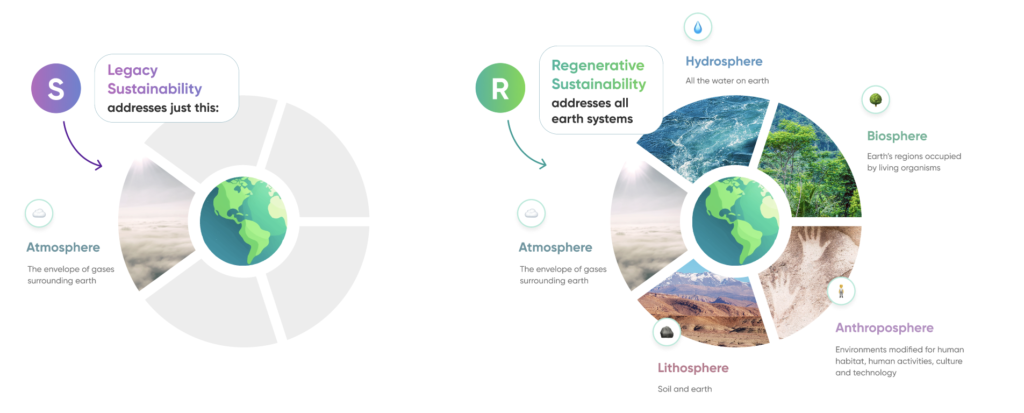By Maria Jose Malpartida Head of Marketing Communications at Handprint | Sustainability Communications Expert –
We’re living in an era where the urgency to address environmental and social challenges is paramount. The effects of climate change are becoming more visible and tangible every month, putting our Planet on a trajectory toward being uninhabitable. Nevertheless, we see Corporate Sustainability at its peak, with almost every single brand taking some sort of action towards reversing the doom and gloom.
Who hasn’t heard of Net Zero pledges, or carbon footprint reduction goals? It’s all over the place!
But here’s the deal – is it enough?
What Is Legacy Corporate Sustainability?
Legacy corporate sustainability refers to mainstream sustainability practices, such as footprint reduction, net zero goals, and carbon offsetting. With its “do less harm” vices, it has worked pretty well traditional industries like manufacturing, energy, mining, and transportation, as these industries have significant environmental footprints, making legacy sustainability a valuable framework for raising awareness and taking action.
Companies in these sectors have made some great progress by adopting more efficient production processes, embracing circularity principles, implementing waste reduction, recycling programs, investing in renewable energy technologies and more. However, legacy sustainability, with its goal of “doing less bad” is just not enough for dealing with our mounting environmental and societal concerns.
The Carbon Tunnel Vision
Imagine a dark long tunnel. You’re standing at the very beginning and you see one thing at the very end.
Do you picture it?
Great.
That’s the Carbon Tunnel Vision that’s dominating today’s corporate mindset. Sure, cutting emissions is a good start, but what about all the other systems moving around the tunnel – biodiversity loss, poverty, hunger, lack of education, water crisis, overconsumption, and the list goes on. Corporates are also responsible in tackling other pressing issues and changing their Carbon mindset towards a broader perspective.
It’s Time to Ask New Questions
It’s clear that legacy corporate sustainability efforts are not longer enough. Things won’t change without a radical new approach to corporate responsibility. It is no longer enough to be “sustainable” – companies must be actively regenerating the planet by growing their net positive effect on the earth’s systems. Regeneration offers a systemic path for companies to move away from an economic system that is extractive and degenerative, and re-create the connection between Humans and Nature. Let me explain…
Regeneration goes beyond doing less harm and instead focuses on actively restoring, renewing, and revitalizing all spheres of planet Earth, emphasizing the connection between environmental, social, and economic systems, and seeks to create net positive impact across these dimensions. Regeneration helps reverse the degradation of ecosystems, enhance biodiversity, and promote the sustainable use of natural resources. In short, Regeneration is about doing “more good” rather than “less bad”.

Is Corporate Sustainability Losing its Competitive Advantage?
Back in the days where post child Unilever, Patagonia, Danone, just to name a few poster childs brough Corporate Sustainability at the core of their business, they showed that by integrating corporate sustainability into their core purpose and business strategy, it brought clear growth.
Unfortunately, regulatory requirements are increasingly turning corporate sustainability into a compliance framework. While this may be good for the planet from a reduction (ie “doing less harm”) perspective it also implies that sustainability itself loses its potential as a competitive differentiator.
Companies that want to lead by example and be recognised for making a real difference need to follow the mentality of doing (1) what their stakeholders want, (2) what the planet needs to heal and (3) what aligns with their brand.
By adopting regenerative practices and integrating them at the core of a business operations and strategy, businesses can contribute to the long-term health of the planet and create lasting value for their stakeholders, simultaneously yielding significant benefits for both the planet and for business.
A Story of Hope
Regeneration is a story of hope that looks at every single living system, and focuses on reversing our planet crisis. It’s about changing the doom and gloom narrative to a positive one, changing the corporate mentality of doing less bad to actually doing good.
Are you curious to read more and learn how to transition to Regeneration? Check out Handprint’s playbook for championing Regenerative practices.
All views and opinions expressed on this site are those of the individual authors and comments on this site are the sole responsibility of the individual contributor.

